Umami International Symposium 2016
October 2016
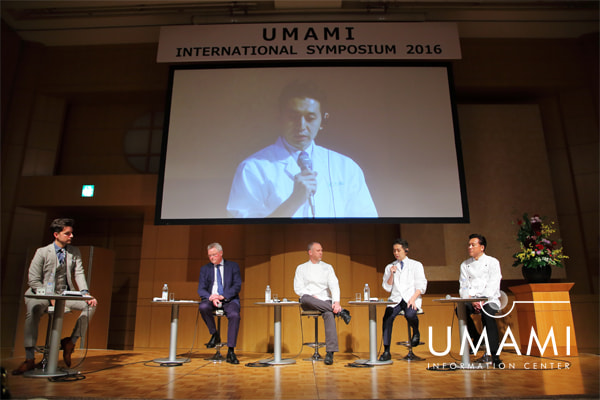
-
- Date:June 5th, 2016 10:30 - 14:50
-
- Venue:Yokohama Bay Hotel Tokyu
Organized by Umami Information Center (NPO)
Under the patronage ofMinistry of Agriculture, Forestry and Fisheries (Japan)
-
- Partner Organizations:The Japanese Association for the Study of Taste and Smell, The Japanese Society of Nutrition and Dietetics, Japan Society of Nutrition and Food Science, The Japan Society of Home Economics, The Japan Society of Cookery Science, Kanagawa Dietetic Association, The Japanese Culinary Academy (NPO)
-
- Participants:Taste scientists, nutritionists, chefs, and journalists, and so on total 104 persons
Reported by Umami Information Center (NPO)
The Umami International Symposium 2016 was held in Yokohama on June 5, 2016. Taste scientists and chefs from the United States, Italy, Denmark and Japan searched for the functions and health benefits of umami through a round-table discussion. Takashi Yamamoto, chairman of the Umami Information Center, delivered the opening remarks. The Umami Information Center teaches that umami is a basic and universal taste. This time, we would like to deepen the discussion on how the taste of umami relates to our healthy dietary life.
Part 1 Umami for the Healthy Eating
◇Moderator:
Gary Beauchamp, Ph.D. : Distinguished Member and Emeritus Director and President,Monell Chemical Senses Center (USA)
◇Panelists:
Julie Mennella Ph.D. : Monell Chemical Senses Center (USA)
Gabriella Morini, Ph.D. : Assistant Professor, University of Gastronomic Sciences (Italy)
Takashi Yamamoto, Ph.D. : Emeritus Professor, Osaka University, Professor, Kio University
Chairman, Umami Information Center (NPO)
Dr. Gary Beauchamp
My first research on umami was in the 1970s, when I studied preference of nursing infants, both well-nourished and malnourished, for umami. An aqueous solution of monosodium glutamate, which is pure umami, wasn't palatable - infants rejected it. However, when umami was added to soup, the palatability of the soup was greatly improved. Even two month old infants preferred soup with umami regardless nutritional status. I think that it is likely that the human's preference for umami is at least partly innate.
Dr. Julie Mennella
The most abundant free amino acid in breast milk is glutamate. Through breast milk, the infant experiences the flavor of foods eaten by the mother along with umami. The fetus experiences the flavors of foods eaten by the mother through the amniotic fluid and then the infant experiences these flavors through mother's milk. In the weaning period, flavor is experienced through baby foods or specially prepared table foods supplied by the mother, father and other caregivers. These experiences are extremely important in forming preferences.
Dr. Takashi Yamamoto
We found that even among animals, their taste experiences in infant affect their preferences after they grow up. This means that first experiences are important. Umami receptors in the tongue, stomach and intestine receive the umami information. The umami information from these receptors is conveyed to the brain to promote digestion and absorption. Recent studies show that various hormones released by umami signal may contribute satiety. This can be said to be a health benefit, can't it? By signals being sent to the brain, we feel something was delicious and want to eat it again. This is important not only for infants, but for adults, too.
Dr. Gabriela MoriniIn
Italy, parmesan cheese is added in baby food. This means that the taste of umami is known and considered important, but the word umami is not known. This is why I teach umami. I teach students that the sense of taste is the language food uses to communicate with us. To know this language makes it possible to understand what we eat, which are the nutrients and in what proportion they are present in food. I want students who will have food-related work to understand taste at the molecular level to convey that taste is a key tool for health.
Wrap Up by Dr. Beauchamp
In 1948 and 1955, a United States military-related organization held two symposia on glutamate with the purpose of making soldiers' meals more delicious. They reported that the taste of glutamate itself is not distinct, unlike the other four basic tastes. It is more subtle and difficult to distinguish, but if it is added to many foods, the tastes and flavors of the foods were more balanced, broader and richer and even thicker appearing. Much more recently, the discovery of umami receptors on the tongue gave strong scientific support for the importance of umami taste for humans. I am looking forward to chefs, who are closer to consumers than scientists, to further spread the importance of umami to the general public.
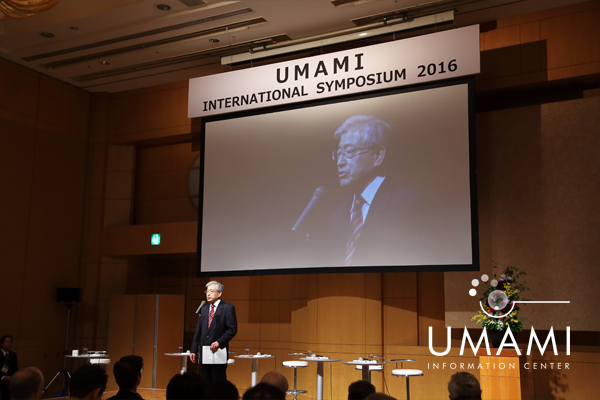
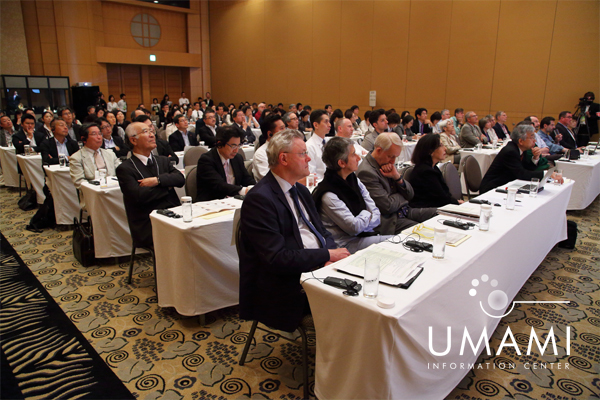
Part 2 Challenge to Umami by Culinary Scientists
◇Moderator:
Ali Bouzari Ph.D : Chef, Ph.D. Food Biochemistry
◇Panelists:
Ole G Mouritsen, Ph.D: Professor, South Denmark University, Advisor, Nordic Food Lab.
Yuji Wakiya : Owner chef, Wakiya Ichiemi Charo
Kyle Connaughton : Owner chef, Single Thread Farm-Restaurant-Inn, Cookbook author, and culinary educator
Takuji Takahashi : Executive chef and third-generation owner, Kyo-Ryori Kinobu
Dr. Ali Bouzari
Umami is not Japanese. The process of liberating the glutamate closed up in the protein of soybeans into a deep flavor through fermentation isn't Japanese and it isn't related to culture. If chefs understand the scientific principles of fermentation, they can create new things from ingredients other than soybeans. Umami is in every kind of cuisine in any country.
Chef Kyle Connaughton
I had an interest in flavor and eating and in the process of my understanding continually evolving, I became fascinated with Japanese cooking and found umami. I learned that it plays an important role in food and, actually, the Thai fish sauce nam pla and England's Worcestershire sauce have umami, and became able to combine various ingredients. When chefs first learn about umami they try making it the star, but umami isn't the main focus. I think we need to learn where umami hides from Japanese cooking.
Chef Yuji Wakiya
Umami in Chinese cooking is in soup. In addition to chicken, pork, scallions and ginger, foods such as dried shiitake and shellfish, which are called dried money, meaning that they have about the same value as money, and Jinhua ham are used as soup ingredients and all have concentrated umami. The umami is gently drawn out over time, giving us Chinese soup.
Chef Takuji Takahashi
Comparing the amount of water in the food of each country, Japanese food is about 80%, Chinese food is about 70%, and western food is about 60%. If the amount of water is different, the state of umami will be different. Japanese food uses liquid umami, centered on "dashi." In infancy, umami is experienced as a liquid through mother's milk and, as one grows and mobility increases, one starts taking umami and nutrients from solids. Umami itself is experienced from infancy and is in mother's milk, dashi, and the unique foods of each region, but aromas are different. In short, umami is the beginning, but it is probably aroma that leads to the resulting preferences.
Dr. Ole G Mouritsen
In northern Europe, umami is from the flavor of meat and soup stock, mushrooms, cheeses and fermented fish. Almost all traditional foods make use of umami. Surstrmming, which is fermented herring, has umami but the word umami isn't used to describe its flavor. I would like to suggest that education about umami be done at kindergartens and in schools. By having chefs and scientists teach young children about umami, I think creative cooking and umami recipes will stimulate eating habits of future generations.
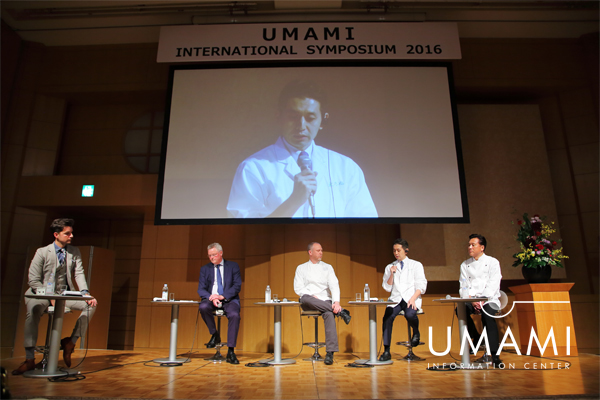
Following discussions, umami recipes, which were prepared by three chefs, were presented.
Nobly Fragrant Chawan Mushi (Salty Egg Custard) by Chef Takuji Takahashi, Executive chef and the third generation owner of Kyoto Kinobu
This is a dish with a high-quality dashi combined with a jelly made with sake infused with the about 20 fragrance components such as cypress and dried fruits. Adding fragrance to the umami of the dashi gives it depth and it is made with a noble flavor.
Donabe Smoked Salmon with Shio Koji, Sesame, and Scallion Sauce by Kyle Connaughton, Owner Chef, Single Thread Farm Restaurant -Inn, Cookbook author, and Culinary Scientist
This is a dish where salmon has been marinated with liquid shio koji and the umami drawn out and then smoked with cherry chips. The smoke flavor and negi and ginger sauce are an accent, making the salmon's umami stand out.
Asparagus and Littleneck Clam Risotto by Yuji Wakiya, Owner Chef, Wakiya Ichiemi Charo
This is a risotto made with plenty of asparagus and littleneck clam, both representative umami foods, and boiled in chicken soup. This dish is impressive for the deep flavor due to the synergy of the umami and the vibrant green of the asparagus.
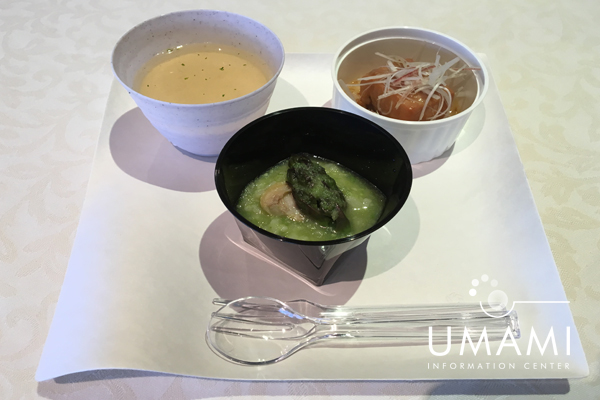
◆UMAMI menu recipe(PDF)DOWNLOAD
It is extremely important for scientists and chefs to give their views about the functions that umami has and how it can contribute to a healthy lifestyle when used well. Also, we are looking forward to that information being disseminated throughout the world.
The Umami International Symposium was a great opportunity to delve into umami from both the scientific and culinary points of view. Furthermore, all participants received information on umami, not only regarding taste, but also its health effects. They commented that the symposium was a wonderful opportunity to deepen their knowledge of umami, that umami has health effects, and that it is good to know the research has already begun.
The Umami Information Center would like to express its appreciation for every participant who attended the lecture and the scientists and chefs who participated in the round-table discussion. Last but not least, we appreciate everyone that has made the symposium very successful.
